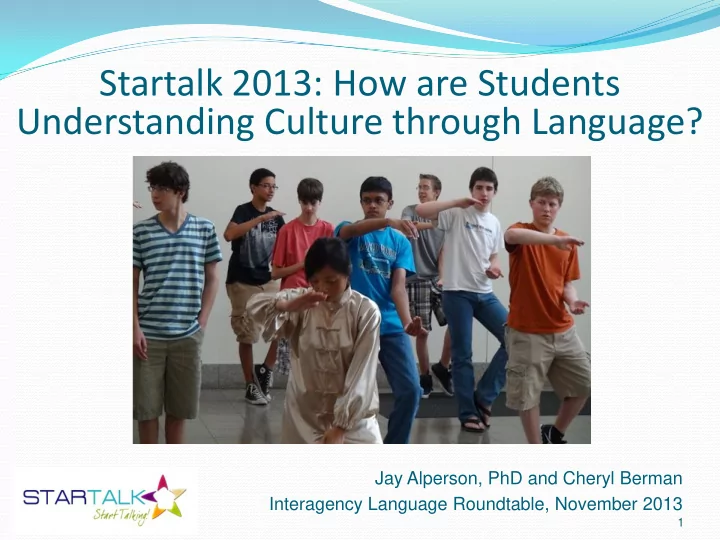

Startalk 2013: How are Students Understanding Culture through Language? Jay Alperson, PhD and Cheryl Berman Interagency Language Roundtable, November 2013 1
Startalk Assessments Instructional Aide Weekly Survey Attitude/Motivation Test Battery (AMTB) Intercultural Development Inventory (IDI) 2
Instructional aides: Attitudes toward Work 3
What is the AMTB? A paper and pencil measure of attitude and motivation regarding learning a second language. Developed by RC Gardner in 1985 Widely used in language acquisition studies HCC adapted it to Startalk’s needs (Gardner RC, Tremblay P, Masgoret A. 1997). 4
Components of the AMTB Motivation – desire to learn the language, and attitudes toward learning the language Parental Encouragement – extent the students are encouraged by their parents Integrativeness – students’ openness, interest and orientation toward a second language Language Anxiety – language class anxiety and language use anxiety 5
Motivation t(71) = 0.901, p>.05, ns Parent Encouragement t(71) = 0.235, p>.05, ns Integrativeness t(71) = 0.372, p>.05, ns Language Anxiety* t(71) = 4.211, p < .05, s *Significant at the .05 level 6
The Intercultural Development Inventory An online test written by MR Hammer (1998) Based on a developmental model of intercultural sensitivity (MJ Bennett, 1986) Widely used by colleges and business Frequently used in studies and dissertations Was administered pre and post 7
Inter-Galactic Commonality and Difference Greetings. I am pleased to see that we are different. May we together become greater than the sum of both of us. Spock, Vulcan Greeting from Star Trek 8
The Intercultural Development Inventory 50 items similar to this: I think most cultures have something to offer. 9
Cultural Proficiency Continuum Adaptation • Cognitive frame- Acceptance shifting • Behavioral code- Monocultural shifting Minimization Mindset Intercultural • Similarity • Universalism Mindset Polarization • Defense • Reversal Denial • Disinterest • Avoidance Modified from the Developmental Model of Intercultural Sensitivity (DMIS), M. Bennett, 1986 Source: Mitchell R. Hammer, Ph.D. 10
Cultural Proficiency Continuum DENIAL Little recognition of more complex cultural differences Adaptation • Cognitive frame- Acceptance shifting Monocultural • Behavioral code- shifting Minimization Mindset • Similarity • Universalism Intercultural Polarization Mindset • Defense • Reversal Denial • Disinterest • Avoidance 11
Cultural Proficiency Continuum POLARIZATION Judgmental orientation: “us” versus “them” Adaptation • Cognitive frame- Acceptance shifting Monocultural • Behavioral code- shifting Minimization Mindset • Similarity • Universalism Intercultural Polarization Mindset • Defense • Reversal Denial • Disinterest • Avoidance 12
Cultural Proficiency Continuum MINIMIZATION Highlights cultural commonality; can mask deeper recognition of difference Adaptation • Cognitive frame- Acceptance shifting Monocultural • Behavioral code- shifting Minimization Mindset • Similarity • Universalism Intercultural Polarization Mindset • Defense • Reversal Denial • Disinterest • Avoidance 13
Cultural Proficiency Continuum ACCEPTANCE Recognizes cultural commonality and difference between own and others’ cultures Adaptation • Cognitive frame- Acceptance shifting Monocultural • Behavioral code- shifting Minimization Mindset • Similarity • Universalism Intercultural Polarization Mindset • Defense • Reversal Denial • Disinterest • Avoidance 14
Cultural Proficiency Continuum ADAPTATION Able to shift cultural perspective and adapt behavior to cultural context Adaptation • Cognitive frame- Acceptance shifting Monocultural • Behavioral code- shifting Minimization Mindset • Similarity • Universalism Intercultural Polarization Mindset • Defense • Reversal Denial • Disinterest • Avoidance 15
Cultural Proficiency Continuum ADAPTATION Able to shift cultural perspective and adapt behavior to cultural context Adaptation • Cognitive frame- Acceptance shifting Monocultural • Behavioral code- shifting Minimization Mindset • Similarity • Universalism Intercultural Polarization Mindset • Defense • Reversal Denial • Disinterest • Avoidance 16
How Startalk students see themselves: Acceptance Recognize cultural commonality and the difference between own and others’ cultures Adaptation • Cognitive frame- Acceptance shifting Monocultural • Behavioral code- shifting Minimization Mindset • Similarity • Universalism Intercultural Polarization Mindset • Defense • Reversal Denial • Disinterest • Avoidance 17
How the IDI sees Startalk students: Low Minimization Highlights cultural commonality; can mask deeper recognition of difference Adaptation • Cognitive frame- Acceptance shifting Monocultural • Behavioral code- shifting Minimization Mindset • Similarity • Universalism Intercultural Polarization Mindset • Defense • Reversal Denial • Disinterest • Avoidance 18
Typical Results from the IDI There are two scores: Perceived Orientation and Developmental Orientation. Perceived Orientation: where you see yourself. Denial Polarization Minimization Acceptance Adaptation Orientation Gap Developmental Orientation: where the test sees you. Denial Polarization Minimization Acceptance Adaptation 19
Startalk Student Results: Perceived Orientation: where they saw themselves. 119.04 Denial Polarization Minimization Acceptance Adaptation Orientation Gap Developmental Orientation: how the test saw them . 87.05 Denial Polarization Minimization Acceptance Adaptation 20
Little change in IDI Scores Perceived Orientation t(80) = --1.451, p> .05, ns Development Orientation t(80) = -1.707, p > .05, ns Orientation Gap t(80) = 1.790, p > .05, ns No significant changes pre to post (p > .05). 21
Questions Jay Alperson, LOA, CL 116/102, 443-518-4707 jalperson@howardcc.edu Cheryl Berman, World Languages, DH 334, 443-518-4861 cberman@howardcc.edu Thanks to Mitchell Hammer, IDI Corporation for many of the images 22
Recommend
More recommend